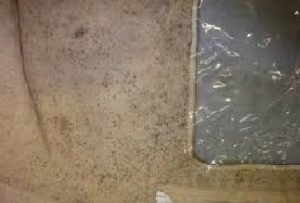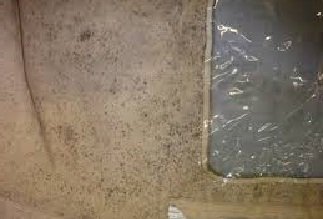Disclosure: this post may contain affiliate links. As an Amazon Associate we earn from qualifying purchases.
Mold on a tent can be unsightly. It may also pose some health hazards especially if the user is allergic to fungus. Generally, it is not safe to sleep in a moldy tent due to the risks involved.
Therefore, cleaning a moldy tent is crucial and it also ensures the fabrics last longer.
Mold or mould in tents usually occur when one forgets and packs their tent while still damp or wet. This fungus grows in the presence of the slightest moisture and other favorable conditions like low light.
This is very common when campers pitch near a water body (e.g lake or river) or during the rainy season.
When rainy weather arrives, on can be forced to quickly pack up when time to head home arrives without drying the tent. Trust me, it has happened to me and my friends.
We found out that hard shell roof top tents tend to grow mold more easily than soft shell ones due to the tight and dark cover.
Contents
How to Clean a Tent with Mold
Campers should wash their tents thoroughly after their adventure. Anyway, don’t be afraid, washing camping tent is an easy and quick process. Although the mold might seem hard to remove, it can be done by employing a few relatively easy steps.
Requirements for Cleaning a Moldy Tent
- Warm water
- Soft brush
- White distilled vinegar
- Non porous gloves
Steps to Getting Mould Off a Tent
-
Gather the mold removing and cleaning supplies
This is the first step where one is required to collect all necessary
items and products. For good results, we recommend use of distilled vinegar and other better alternatives.
-
Brush off the tent mold
Use a soft brush to remove the visible mold off the tent. This should be done gently.
-
Wear a non-porous gloves before cleaning with vinegar
Extended exposure to vinegar can cause skin irritation. Gloves ensure your hands are protected against vinegar’s natural and organic composition effects.
-
Fill a spray bottle and fill with distilled white vinegar
Make sure not to dilute the pure vinegar with water. As a result, ensure you have adequate vinegar to clean all the surfaces that are affected by mold.
-
Spray the vinegar thoroughly on affected area of the canvas
Cover the affected area with distilled vinegar. Ensure you apply adequate amount for better results. This will make sure that there is enough quantity to kill the mold.
In case, you do not have a spray bottle it is advisable to use a disposable cloth. Then, wipe the affected area to ensure that is completely soaked in vinegar.
-
Allow the vinegar to sit for around one hour
Although it takes less time for vinegar to remove mold and mildew by breaking it. It is advisable to allow to sit on tent for around an hour before scrubbing it. This will offer the vinegar adequate time to break and completely work on mold.
-
Scrub the mold away with a scrub brush and warm water
Using a scrub brush, scrub the areas affected by mold thoroughly. These are areas sitting on vinegar. Make sure to clean your brush regularly in warm water as you work through the moldy areas.
Scrub brush will assist in making it easier to break up the mold. Choose a brush that is ideal for your cleaning job a bigger brush will clean large surface will small brush may assist in reaching out for cracks.
-
Wipe the affected areas clean
Once you are done with dislodging the mold from tent surface, wipe the surface clean using warm water. If the mold persists, repeat the entire process until all the mold is removed.
However, it is likely that vinegar will leave behind strong unpleasant odor which will fade away quickly
-
Dry the tent
This the sixth step of cleaning mold in a camping tent. Hang up you tent to air dry. Otherwise, you can pitch the tent and ensure it air dries that way. It is quite necessary to allow the camping tent to dry completely before packing it in storage.
In case, the tent is kept damp or wet, it will grow molds quickly. This can attract rapid mold growth requiring intensive cleaning to remove.
-
Mix vinegar with other products to boost its killing power
Vinegar is believed to kill approximately 82% of different mold species. Then, if this is true there is 18% possibility of persistent species re-occurrence.
Thus, it is advisable to mix vinegar with either hydrogen peroxide, borax, salt or baking soda. However, make sure not to mix vinegar with bleach, this can create toxic and dangerous fumes.
-
Spray tent with vinegar to curb future mold growth.
Once the surface is clean you are required to spray it with vinegar to keep mold from returning. Lastly, always ensure you use regular distilled white vinegar.
Summary
If your tent gets moldy, it is necessary to undertake special instructions. These will make the next camping experience incredible because the tent will be safe for usage. Brush with soft bristles which are ideal in removing loose mold.
In this case, we recommend special mold cleaning products like vinegar which kills mold spores completely. Vinegar may be mixed with hydrogen peroxide, borous, salt or baking soda to enhance its killing powers.
If the mold is minimal and new, it is easy to wash you tent using just soapy hot water. Nevertheless, there are several home based mold removers such as hydrogen peroxide, lemon juice, mixture of salt or vinegar and water.
Avoid bleach because it might damage the tent fabric and fade its color.
The most appropriate way to prevent future mold attacks its necessary to keep your tent as dry as possible. Always ensure the tent is dry after camping before storing this fabric.
In addition, make sure not to store your tent in damp and hot place. Use an odor eliminator such as Mirazyme and Revivax to get rid of smell coming from mold. Lastly, store your newly washed tent in a cool, dry place.
We hope we have answered your query concerning how to clean a tent with mold. Enjoy your fresh tent.
Amazon and the Amazon logo are trademarks of Amazon.com, Inc, or its affiliates.


